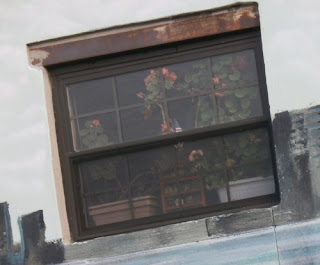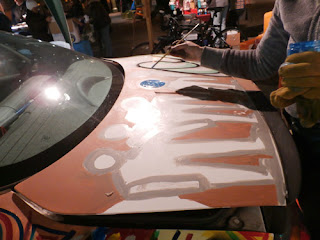No one needs a reminder of how fleeting life can be, of how security and what you know are illusions, or at least temporary. Your reality and expectations can disappear without notice, less than a second. What you know is gone. Life was one way for you, now it’s another.
We don’t need a reminder that any plan making is potentially futile.
We get that reminder anyway.
Jersey City was a gelid mess on the Wednesday before Thanksgiving. Residual cold rain and sleet from a Nor’easter that we mostly avoided made for damp and chilly afternoon. A four alarm fire broke out. I got there about two hours, missed the blaze but the smoke was thick, the acrid stench still on the clothes hours after I got home.
Four Alarm fire, Grove Street. Streets were closed off, you could only get so close. Fire trucks were parked on Newark, which runs perpendicular, and a ladder stretched to the roofs, fire fighters climbed the rungs across the street to the backs of the buildings, the sides not facing Grove.
On Grove, the hoses were going full-force. Everyone was still serious. Water was everywhere. Hoses were hooked to the fire hydrant, over-flow was streaming from the pumps on the truck, mixing with the cold rain and icy splinters of sleet. The smoke hovered around us like a wad of cotton, commuters walking home slipped their scarves over their mouths. You could taste the smoke.
Three days ago… pizza was being eaten, nails were being manicured… 22 people had homes and beds to sleep in… today, two buildings now rubble… the work went on all Thanksgiving night, Black Friday morning… police just standing guard… “we don’t want people messing with the rubble, it’s dangerous… they come looking for pipes, metal parts, they’re professional scavengers.
So, some firemen and police got some overtime. About eight in the morning, the Boun Appetito awning is on the sidewalk, the Tender Shoots produce bodega proprietors tell me they were working all night putting out the fire.
So, some firemen and police got some overtime. About eight in the morning, the Boun Appetito awning is on the sidewalk, the Tender Shoots produce bodega proprietors tell me they were working all night putting out the fire.
Come back to town after visiting with Mom for Turkey Day around Six, they’re working still. Big spotlights s on full incandesce, so bright you could read, the Buon Appetito building is entirely knocked down, the cherry picker gizmo was maneuvered between the drooping phone and electrical cables draped between the poles, the few spectators were saying they have to knockdown that building too.
I noticed the shelves were empty in J Nails, the nail salon; the first place I ever had a pedicure, a very rare indulgence, really nice folks, clean, in between customers the owners, Korean, would read their bibles. Their workers were all young women, some Korean but mainly from Central America, they made me feel comfortable. They were sweet. Thick accents, poor English skills, communication was an amusing chore.
Buon Appetito made above average pizza, it was an above average place. I loved their calamari and they would do grilled asparagus and zucchini and a broccoli rabe with sausage. Clean, good food, real friendly staff. What a great place.
These neighborhood joints, you discover them, go frequently for a while and for no real reason beyond whim and circumstance, the frequency fades. Yet, these were good businesses, they were down-home and affordable, like the old neighborhood this part of Jersey City used to be, and yet were not out of place in the new, more exclusive neighborhood emerging, in spite of any resistance. You think of them fondly and when you had a chance to again partake of their business, it was a pleasure.
The day after Thanksgiving – Black Friday, maybe you’ve heard – both buildings reduced to rubble. The businesses in the adjacent buildings were closed, in the apartments above the businesses the lights were off. The effects of this local catastrophe may still be determined.
It’s shocking to see, the pile of charred rubble. The view from the back of the buildings, more wreckage.
The actual fire was extinguished in an hour to two, under control in about four, but was enough time for the flame to make these old buildings unstable and uninhabitable. You sense the abrupt loss, the aftermath of destruction. The disaster contained, one moves on. When the disaster is in your neighborhood, that feeling of loss is more tangible and constant. It tarries. You get a daily taste of anguish, and you know that for at least 22 others, it’s more than a taste. We’ll think of this now every time we pass this hole on the 300 block of Grove Street. The rubble will be carted away, new buildings erected, a process that will take more than a year for sure. We will have the memories of what was here and of the day what was here was suddenly gone. Remember the Thanksgiving of 2013?
No lives were lost, just businesses and homes and possessions. Hundreds of others experiencing lesser digress of inconvenience, from the firemen and demolition workers who had to spend Thanksgiving on the job to the more minor detours people who walk this stretch of Grove Street now must take. Life is shared in a city. Something like this happens, were all affected even though we are all affected differently. You pray for your neighbors affected more severely.
These 22 people were being helped by the Red Cross. Without warning, without explanation, Thanksgiving plans erased and they were immediately turned into refugees. By mid-day Black Friday Facebook newsfeeds had announcements of fundraisers for the victims of the Grove Street fire. Living in a city, it is not as eBay and often not even possible to escape the feeling of loss, or the reactions to that loss,
You read about a tragedy somewhere else, you
have some empathy. But when it’s where you live, that empathy is more
inescapable. You just want to help if you can, you’re compelled to express
support or comfort.
These 22 people were being helped by the Red Cross. Without warning, without explanation, Thanksgiving plans erased and they were immediately turned into refugees. By mid-day Black Friday Facebook newsfeeds had announcements of fundraisers for the victims of the Grove Street fire. Living in a city, it is not as eBay and often not even possible to escape the feeling of loss, or the reactions to that loss,
Small businesses are lifelines. They give city dwellers quality of life, the ordinary respites of our day-to-day. A manicure, a slice of pizza with sausage and suddenly the moment you are in turns perfect even if just for that moment. But that can be enough, that can be all that is needed to endure certain days.
That potential of a perfect moment has been burned away. Not forever, just for now.
Those owners and workers in these business, those who lived in the apartments above those businesses, seeing this same rubble we all are gawking at, we can only taste the anguish they have, help if we can, let them know they’re not alone.
Friday night a paper handbill was taped to a parking meter in front of the once buildings now massive pile of debris. Customers were alerted that J Nails will be in a new location soon. They were being directed to a Facebook I could not find.
Somebody showed up for the mani-pedi appointment, probably get them everybody Friday and they saw this.
We don’t need these reminders. But we get them anyway.

























































